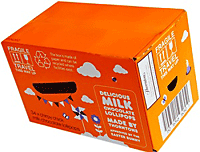 More packaging, not less packaging, could help the environment—by reducing the amount of food waste going to landfill, according to the U.K.-based Confederation of Paper Industries (CPI) Corrugated Sector. Around 7 million metric tons of edible food ends up in landfill in the U.K. each year at a staggering cost to household budgets, the economy, and the environment, CPI notes, adding that it is "pleased to confirm that the packaging industry is playing its part in reducing waste with significant investment in preventive steps such as providing easier opening solutions, clearer date labelling, and smaller pack sizes."
More packaging, not less packaging, could help the environment—by reducing the amount of food waste going to landfill, according to the U.K.-based Confederation of Paper Industries (CPI) Corrugated Sector. Around 7 million metric tons of edible food ends up in landfill in the U.K. each year at a staggering cost to household budgets, the economy, and the environment, CPI notes, adding that it is "pleased to confirm that the packaging industry is playing its part in reducing waste with significant investment in preventive steps such as providing easier opening solutions, clearer date labelling, and smaller pack sizes."
CPI also points to figures released by The Industry Council for Packaging and the Environment (INCPEN) on energy consumption in the food supply chain. INCPEN's research shows that primary and secondary packaging makes up just 10% of the total energy used in feeding one person for a week (Table for One, an INCPEN report on energy usage in the food supply chain), compared with 51% in the production stages and 31% for home storage and cooking.
Corrugated packaging is playing a pivotal role in supply chain sustainability by ensuring that more food reaches the consumer's table as safely and efficiently as possible. Corrugated producers have invested heavily in moving from a brown box for goods in transit to a three-in-one shelf ready packaging solution comprising product protection, an advertising platform, and merchandiser, CPI says. The advantages that corrugated is bringing to the supply chain are a result of continued investment in printing techniques, allowing greater product presentation on outer packaging, which is proving a big hit with retailers, it adds.
Packaging materials to combat food waste are also being developed, with some supermarkets trialling corrugated board that utilizes an ethylene-absorbing agent to slow down fruit and vegetable ripening to help them stay fresher for longer. CPI's Director of Packaging Andy Barnetson says that corrugated packaging's protective qualities are supporting the food industry's sustainability goals by keeping products fresher for longer, whereas reducing packaging could increase food waste. "Diverting waste from landfill sites is very important," he points out. "The corrugated industry is proud to use and promote a sustainable and renewable material, more than 80% of which is recycled, saving an area of board the size of Greater London from landfill every four months.
"Packaging helps to protect food in transit as well as preserve its freshness on arrival at the retailer," Barnetson continues. It also uses far less energy in the supply chain than the production and cooking processes. By preventing food from going off, it is saving far more in resources than those used in the packaging itself. The best environmental solution can be more packaging rather than less. To suggest that more packaging for food could be beneficial for the environment might bring howls of protest from the green lobby, but surely in a world where billions of people are at risk of hunger, saving from landfill as much of this most basic of human needs as possible, is crucial."
TAPPI
http://www.tappi.org/